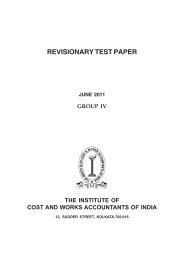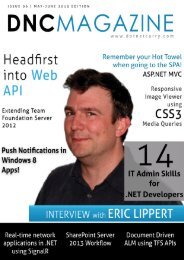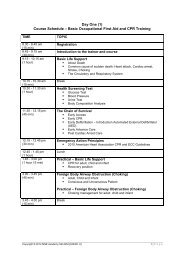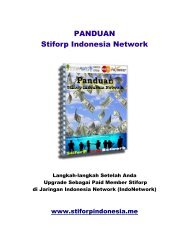Eric lippert - Amazon Web Services
Eric lippert - Amazon Web Services
Eric lippert - Amazon Web Services
Create successful ePaper yourself
Turn your PDF publications into a flip-book with our unique Google optimized e-Paper software.
Team foundation server<br />
Team Foundation Server<br />
Extending Team Foundation<br />
Server 2012<br />
ALM MVP Subodh Sohoni shows us the various extensibility points available<br />
in TFS and how to leverage them to align TFS to (existing) processes instead<br />
of the other way round!<br />
S<br />
ervices of Team Foundation<br />
Server 2012 (TFS 2012) have<br />
a rich set of features to<br />
support generic application<br />
lifecycle management out of box. These<br />
services are to provide support of version<br />
control, build management and project<br />
management through work item tracking.<br />
In addition to these core services, TFS<br />
2012 also offers reporting of data<br />
generated during development activities<br />
and a collaboration portal for each<br />
software project undertaken by the team.<br />
It supports the process models based<br />
upon CMMI, Agile and Scrum.<br />
All these features are provided with<br />
certain default settings. These settings of<br />
the features make TFS behave in a certain<br />
way. It is the way these features are<br />
commonly used. But, it is also true that<br />
the way each feature is designed, cannot<br />
satisfy everyone’s requirement. In fact,<br />
more the generic nature of these features,<br />
more are the chances that it may not<br />
satisfy anyone. The way organizations<br />
behave are, as per the set processes that<br />
they have implemented over the years<br />
and those processes may not be<br />
supported by the default behaviour of<br />
TFS. It is possible that those processes<br />
have evolved over the lifetime of the<br />
organization and embodies the decisions<br />
made during each unique situation that<br />
the organizations passed through. It is<br />
very difficult to say if processes<br />
followed by an organization are wrong,<br />
although those may not be exactly as<br />
implemented in TFS. Processes often<br />
gives a unique identity to the<br />
organization and those should not be<br />
changed if those processes are working<br />
for that organization. Tools like TFS may<br />
provide efficient ways to implement the<br />
same processes and flexibility of the tool<br />
to accommodate various processes of the<br />
organization, becomes its strength. TFS<br />
2012 does provide many different<br />
opportunities to us to extend its services,<br />
so that we may implement specific and<br />
not just standard processes with it.<br />
Start of the implementation of a process<br />
is with the Process Template which is a<br />
set of configurations that are applied to a<br />
team project when it is created. It<br />
provides configuration of TFS 2012 that<br />
has pre-built process templates and<br />
supports implementation of CMMI, Agile<br />
and Scrum. Organizations can pick any<br />
one of them as a starting point but need<br />
not be satisfied with settings that are out<br />
of box.<br />
The strongest point of these process<br />
templates is that they are customizable. It<br />
is possible to:<br />
58 | DNCmagazine www.dotnetcurry.com

















